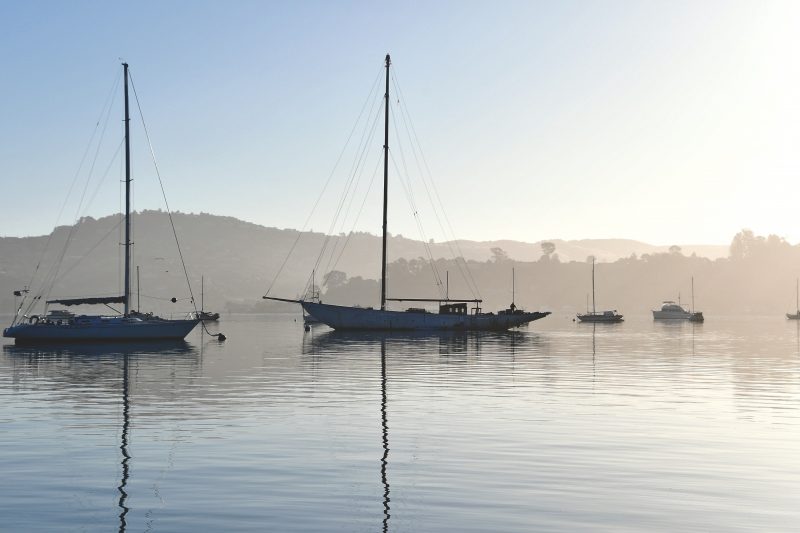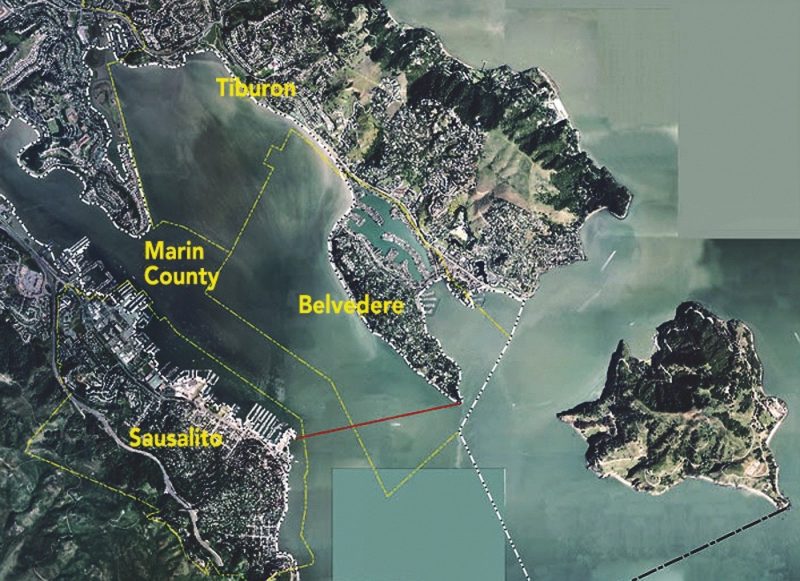
Sausalito to Place Anchor-Outs in Slips
The city of Sausalito is about to begin a pilot program that would place long-term anchor-outs in liveaboard slips in local marinas. The new program is part of the city’s continuing efforts to find solutions for Richardson Bay’s anchor-out community. If successful, the program may see broader application in both the city of Sausalito and Richardson Bay as a whole.
The “Safe Harbor” program is expected to start “very soon,” according to Sausalito city council members. The city, which is fronting $25,000 for the program, is preparing to launch the program imminently with two boats that will eventually receive subsidized liveaboard slips. “We will ramp up to the full eight-boat pilot program once we have identified adequate funds,” said councilmember Joan Cox.
Councilmember Jill Hoffman said that Sausalito is seeking out and vetting applicants who must apply for Safe Harbor if they want to participate. “This is something new that no one has tried — it’s a little bit outside the normal box, so we have to provide evidence and justification when applying for funds. A successful pilot program would be [one] that we are able to help people who are at risk and living on the water transition to a more stable, self-sufficient living situation and able to access support programs. We will learn a lot during the first few months of the pilot; the idea is that we will adjust as we progress.
“Part of the ethos of Sausalito is liveaboards,” Hoffman added. “If they’re not criminals and have decent boats, they are welcome to apply for the program.”

Hoffman added that many of the “support programs” offered in Safe Harbor is through a partnership with the Ritter Center, a San Rafael- based nonprofit that works to prevent homelessness.
“The reason that I believe Sausalito marinas are willing to work with us is that they’ve seen success in the city’s waterfront management plan, which has really focused on unoccupied boats and marine debris,” said councilmember Joan Cox. Following its departure from the Richardson’s Bay Regional Agency, or RBRA, Sausalito began collecting data on boats in its waters. Many boats were classified as marine debris (which, as we’ve reported, can be a contentious definition), while other boats were determined to be unoccupied. Technically speaking, every single boat on Richardson Bay is restricted to a 72-hour stay, but for decades, that ordinance was not enforced. Within the last year, however, Sausalito began serving notices. Some boats left for other waters or got slips, and some boats were confiscated and destroyed.
“All the data helped develop our policy moving forward,” said Hoffman. Sausalito currently has some 18 boats in its waters. “That’s down from a high of 77 in 2017,” Hoffman said. Between 8 and 16 boats are viewed as being occupied either part- or full-time. As the Wall Street Journal recently wrote — and as we have reported at length — Sausalito’s anchor-out community is seen as a symptom of the Bay Area’s housing crisis. It’s important to say that not all anchor-outs are considered homeless. Some people are seasoned mariners who prefer the lifestyle. But many people fall into a gray area.

“We voted unanimously not to take any action against the legacy anchor-outs,” said Cox. “We did extensive research with the assistance of a law firm who are experts in maritime law — there’s no doubt that we have the authority to enforce our regulations. But we are going to offer people an alternative, which is the Safe Harbor program. We are going to provide social services, help people find jobs, provide showers, and offer free food to assist participants in the program.
Cox said that not everyone wants the Safe Harbor program, including both anchor-outs and people in the community worried about the tax burden and concerned about safety. “Some anchor-outs want to be out on the water. I meet with anchor-outs every weekend, and many do want to come off the water. Although many anchor-outs are considered homeless, they don’t consider themselves homeless. They consider themselves slip-less.
“I met one resident who thinks we’re going to raise taxes to fund Safe Harbor,” Cox continued, explaining that Sausalito plans to use its Tidelands Fund, which is money devoted to waterfront issues. “We are not raising anyone’s taxes or increasing tax burden on any other group.”
Hoffman said that Safe Harbor does represent a “substantial cost to the city, so you have to have good reason to use people’s money. But we think it’s worthwhile if you can help a person out of a desperate situation, and offer counseling [on issues] that led them to be in that situation.” Hoffman said that people must be in good standing with the law in order to be accepted into the Safe Harbor’s program.
When reporting on anchor-outs in the Oakland Estuary, we advocated for compassion when considering the homeless problem. We’d like to think that being good neighbors will ultimately create a better, safer community. But that requires that everyone — especially people who have drug problems and have been living on the fringes — act as good neighbors when they come into a marina.
We also cited a study of the Bay Area that found that providing housing for the homeless is actually cheaper than having people bounce through various social services.
“If this program is successful,” Cox said, “we’ll save money because we spend so much on resources to rescue people.” Both Cox and Hoffman mentioned a Marin firefighter who was injured trying to rescue a couple from a rowboat caught in a storm in January. “We already invest a number of city resources for managing the anchor-outs who live in our waters. We hope [Safe Harbors] will cut back on those resources.”
If Safe Harbors is ultimately deemed effective, Cox said that it may be expanded both in Sausalito and to anchor-outs in other jurisdictions within Richardson Bay.
“I just gave a talk in Southern California, and there’s a marina in Orange County considering something similar,” Cox said.
This story has been updated.

Wondering if I can get a free slip if I anchor out longer than XX days… It will create massive “free rider syndrome” – I suspect the “application list” will be as long as your arm… Where can I apply? 😉
Is anyone with a boat really homeless?
How much of an actual problem are the anchor outs? Because if they follow the key rules (I would mostly worry about pollution) then it shouldn’t affect anyone, other than perhaps their sense of order and propriety, and nose orientation. (Could I suggest a bit more downhaul on nasal sail?)
Are they going to get BCDC to allow marinas to increase the number of liveaboard slips to accommodate this plan or are they just going to put these people to the front of the line ahead of those who have been on waiting lists for years for already scarce liveaboard slips? It seems creating a decent mooring field with reasonable rules & possibly providing mobile pump-out services might be more economically viable than forcing people into marinas where any available slip is at a premium.
The article addresses the majority of the people who are anchored want a slip so I applaud the kind people who are willing to put their money to help those “living on the fringe”. I have chosen to hang on my hook in various parts of my State and it is very difficult with aging, disabilities and weather conditions to even have a regular shower and good sleep or meal. Even harder is medical treatment because of the uncertainty of the ability to get to appointments which are set many weeks out…..
Time is of the essence for this program and others to definitely work outside the box. If anywhere in thw world can lead the way to get people housed and into safer places, Sausalito can and should! I remember the early bohemian spirit there and know that there is plenty of room for creativity! Thankful and looking forward to the next step….
Candy — Yes, the city of Sausalito has requested that the BCDC raise the liveaboard quota at marinas in order to accommodate this program. You’re right, though, people in this program may effectively be “cutting in line” ahead of sailors that have been waiting for a liveaboard slip for years.
There’s just no polishing that one up — that’s just a bummer for those people on the list who have played by the rules.
Regarding the cost effectiveness of the pilot program vs. a mooring field: In 2015, the Sausalito City Council estimated the cost of a mooring field to be approximately $5 million, of which Sausalito would have funded roughly 27% (that’s $1,350,000). At present, Sausalito is putting up $25,000 for the pilot program. The city believes that though the liveaboard program, they can improve safety and environmental management at a far lower cost. They’re also trying to help people “transition off the water” to shore side homes, and don’t believe that anchoring-out is a safe option for many people currently on the hook.
With all of that said, we at Latitude 38 still think there should be a big, beautiful mooring field in the Bay Area! We don’t know who’s going to pay for it, but, as the founder of Latitude has pointed out many times, the rest of California has figured this out — why can’t we?
My reaction? I guess the old adage “If you can’t say anything nice, don’t say it.” applies here. One word comes to mind: “Enabling.”
This issue clearly raises passions. I want to say thank you to Tim and the Lattitude 38 crew for reporting on this issue in such a professional and thorough manner.
I also want to recommend this piece by Joe Kloc in Harper’s to anyone interested in the human aspect of anchor outs in Richardson Bay: https://harpers.org/archive/2019/05/lost-at-sea-richardson-bay/
Sounds good moving in a month .